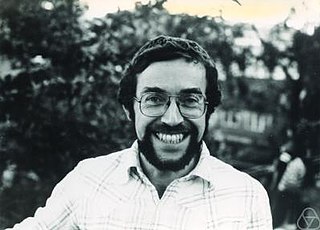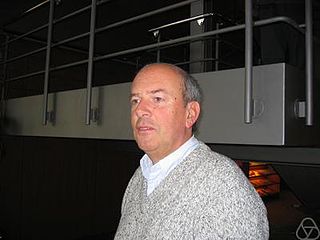
Alexander Grothendieck was a stateless and then French mathematician who became the leading figure in the creation of modern algebraic geometry. His research extended the scope of the field and added elements of commutative algebra, homological algebra, sheaf theory, and category theory to its foundations, while his so-called "relative" perspective led to revolutionary advances in many areas of pure mathematics. He is considered by many to be the greatest mathematician of the twentieth century.

Pierre René, Viscount Deligne is a Belgian mathematician. He is best known for work on the Weil conjectures, leading to a complete proof in 1973. He is the winner of the 2013 Abel Prize, 2008 Wolf Prize, 1988 Crafoord Prize, and 1978 Fields Medal.
In mathematics, crystals are Cartesian sections of certain fibered categories. They were introduced by Alexander Grothendieck (1966a), who named them crystals because in some sense they are "rigid" and "grow". In particular quasicoherent crystals over the crystalline site are analogous to quasicoherent modules over a scheme.

Pierre Émile Cartier is a French mathematician. An associate of the Bourbaki group and at one time a colleague of Alexander Grothendieck, his interests have ranged over algebraic geometry, representation theory, mathematical physics, and category theory.

Pierre Berthelot is a mathematician at the University of Rennes. He developed crystalline cohomology and rigid cohomology.
In mathematics, the Milnor conjecture was a proposal by John Milnor (1970) of a description of the Milnor K-theory (mod 2) of a general field F with characteristic different from 2, by means of the Galois cohomology of F with coefficients in Z/2Z. It was proved by Vladimir Voevodsky.

Gisbert Wüstholz is a German mathematician internationally known for his fundamental contributions to number theory and arithmetic geometry.
John Willard Morgan is an American mathematician known for his contributions to topology and geometry. He is a Professor Emeritus at Columbia University and a member of the Simons Center for Geometry and Physics at Stony Brook University.
In algebraic geometry, a supersingular K3 surface is a K3 surface over a field k of characteristic p > 0 such that the slopes of Frobenius on the crystalline cohomology H2(X,W ) are all equal to 1. These have also been called Artin supersingular K3 surfaces. Supersingular K3 surfaces can be considered the most special and interesting of all K3 surfaces.
In mathematics, crystalline cohomology is a Weil cohomology theory for schemes X over a base field k. Its values Hn(X/W) are modules over the ring W of Witt vectors over k. It was introduced by Alexander Grothendieck and developed by Pierre Berthelot (1974).
In algebraic geometry, Monsky–Washnitzer cohomology is a p-adic cohomology theory defined for non-singular affine varieties over fields of positive characteristic p introduced by Paul Monsky and Gerard Washnitzer (1968) and Monsky (1968), who were motivated by the work of Bernard Dwork (1960). The idea is to lift the variety to characteristic 0, and then take a suitable subalgebra of the algebraic de Rham cohomology of Grothendieck (1966). The construction was simplified by van der Put (1986). Its extension to more general varieties is called rigid cohomology.

Lucien Serge Szpiro was a French mathematician known for his work in number theory, arithmetic geometry, and commutative algebra. He formulated Szpiro's conjecture and was a Distinguished Professor at the CUNY Graduate Center and an emeritus Director of Research at the CNRS.

Corrado de Concini is an Italian mathematician and professor at the Sapienza University of Rome. He studies algebraic geometry, quantum groups, invariant theory, and mathematical physics.

William Messing is an American mathematician who works in the field of arithmetic algebraic geometry.
James S. Milne is a New Zealand mathematician working in arithmetic geometry.
In algebraic geometry, F-crystals are objects introduced by Mazur (1972) that capture some of the structure of crystalline cohomology groups. The letter F stands for Frobenius, indicating that F-crystals have an action of Frobenius on them. F-isocrystals are crystals "up to isogeny".
In mathematics, infinitesimal cohomology is a cohomology theory for algebraic varieties introduced by Grothendieck (1966). In characteristic 0 it is essentially the same as crystalline cohomology. In nonzero characteristic p Ogus (1975) showed that it is closely related to etale cohomology with mod p coefficients, a theory known to have undesirable properties.

Ralph Martin Kaufmann is a German mathematician working in the United States.
Serguei Barannikov is a mathematician, known for his works in algebraic topology, algebraic geometry and mathematical physics.
Ahmed Abbes is a Tunisian-French mathematician and a Director of Research at the Institut des Hautes Études Scientifiques (IHÉS). He is known for his work in arithmetic geometry.









